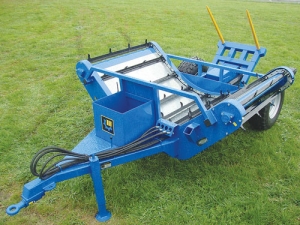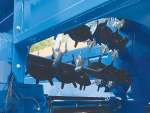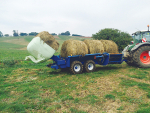A recently introduced double bale feeder by McIntosh builds on the company's reputation for heavy duty products maintaining best practice design, engineering and production.
The chassis consists of two box sections that run through the cradle to increase overall strength; this layout also reduces the overall loading height of the machine and lowers the centre of gravity, promoting safe use on hillsides or sloping ground.
A 315mm conveyor overhang and tyres kept close to the chassis prevent dispensed feed from being run over and contaminated.
The wheel equipment can be set to 1620, 1720 or 1940mm spacing for safety on difficult terrain or to accommodate larger tyres. As part of the package, machines are supplied with 11.5 x 15.3 tyres as opposed to the more typical 10.5. This reduces rolling resistance and makes the machines easier to tow in poor conditions.
Bales are lifted onto the cradle by an over-dimensioned lifting arm strong enough to carry a second bale to the feeding area.
The loading arm has twin lifting rams which gently lower the bale onto the unrolling cradle and help prevent damage to the feeder bars. The unrolling cradle uses a 12,000lb rated chain that is zinc plated, fully guided and driven by 8-tooth sprockets – rather than the more typical 6-tooth set-up favoured by competitors.
The hydraulic motor is rated to 3000psi and uses a 1.25 inch shaft and oversized keyway, said to better resist repetitive changes in rotation.
Unloading slats are made from 8mm steel with integral teeth to promote bale rotation by increasing the contact area; and in the cradle, aggression pins restrict bale movement to encourage the teeth to pull the bale apart.
On the underside, the main driveshaft is shielded to prevent 'wrapping', the plate steel floor is galvanised for a long life, and a swivel drawbar is supplied as standard equipment.
The machine has a rubbish bin and a checker-plated platform on the drawbar A-frame to allow the user to safely remove film and net wrap.
www.mcintosh.net.nz



















